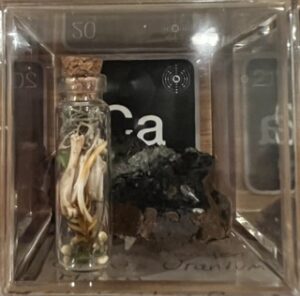Calcium
Atomic Number: 20
Atomic Mass: 40.078 u

Calcium is the fifth most abundant element in the Earth’s crust and is essential for living organisms. In its pure form, calcium is a soft, silvery-white alkaline earth metal. However, it’s never found in this elemental state in nature due to its high reactivity; it’s always combined with other elements.
Key Uses of Calcium in Modern Society
1. Health and Nutrition
- Bone and Teeth Health: Calcium is crucial for developing and maintaining strong bones and teeth. It makes up about 1-2% of adult human body weight, with 99% of it found in bones and teeth.
- Dietary Supplements: Calcium supplements are widely used to prevent and treat calcium deficiencies, especially in populations at risk of osteoporosis.
- Medical Use: Calcium compounds, like calcium carbonate and calcium citrate, are used to treat various conditions, including heartburn, acid reflux, and calcium deficiency.
2. Construction and Building Materials
- Cement and Concrete: Calcium compounds, particularly calcium oxide (lime) and calcium sulfate (gypsum), play a significant role in the production of cement and concrete, crucial materials in construction.
- Plaster: Calcium sulfate in the form of plaster of Paris is widely used for coating walls and ceilings, and in making sculptures and casts in orthopedics.
3. Industrial and Chemical Applications
- Steel Manufacturing: Calcium is used as a deoxidizer, desulfurizer, and decarbonizer for various steel and iron-making processes.
- Water Treatment: In water treatment processes, calcium compounds help remove impurities and soften hard water.
- Paper Industry: Calcium carbonate is used as a filler and coating pigment in the production of paper.
4. Agriculture
- Soil Conditioner: Calcium compounds, especially lime, are used to neutralize acidic soil, improving soil quality and crop yields.
- Animal Feed: Calcium is an essential component in animal feed, ensuring the proper development of bones and teeth in livestock.
5. Food Industry
- Food Additive: Calcium salts like calcium chloride and calcium acetate act as firming agents, stabilizers, and preservatives in various food products.
Environmental and Health Considerations
While calcium is essential for life, excessive intake can lead to health problems,
such as kidney stones and cardiovascular issues. Environmental management is also necessary when using calcium in industrial applications, as improper disposal of calcium-containing compounds can lead to soil and water pollution.
Conclusion
Calcium’s role extends far beyond its well-known presence in bones and teeth. From building the infrastructure of our cities to its use in various industries and its critical role in nutrition and health, calcium is a remarkably versatile element. Its ubiquitous presence in our daily lives underscores the intricate ways in which different elements of the periodic table are woven into the fabric of our existence. As we continue to explore and harness the properties of calcium, it serves as a shining example of the profound impact that even a single element can have on our world, both in nature and through human ingenuity.
Hey kids, are you ready to learn about calcium? It’s not just in milk and cheese; calcium has some really cool secrets! Let’s explore some fun and interesting facts about this amazing element.
- Super Strong Bones and Teeth: Calcium is super important for making your bones and teeth strong. In fact, your bones and teeth store 99% of your body’s calcium – it’s like their superpower ingredient!
- Not Just in Dairy: While milk, cheese, and yogurt are famous for having lots of calcium, it’s also found in lots of other foods. Green leafy vegetables like spinach and kale, as well as almonds and oranges, are great sources of calcium too.
- Glow in the Dark: Did you know that calcium can glow in the dark? When mixed with certain substances, calcium can create a cool, glowing effect. That’s why it’s sometimes used in fireworks to create bright colors.
- Calcium in Caves: Stalactites and stalagmites, those cool pointy things you see in caves, are made from calcium! Water drips down, leaving behind calcium that builds up over many, many years.
- A Key Player in Sports: Calcium helps your muscles work. When you’re playing sports or just running around, calcium is at work inside your muscles, helping them move and contract.
- It’s an Earthly Star: Calcium is not just in your body and food; it’s also found in rocks and soil. In fact, it’s the fifth most abundant element in the Earth’s crust.
- Chalk and Eggshells: Chalk and eggshells are made from calcium compounds. So, when you write with chalk on a chalkboard, you’re using calcium!
- A Soft Metal: In its pure form, calcium is a soft, silvery-white metal. It’s so soft that you could cut it with a knife, but you won’t find it like this in nature because it’s very reactive.
- Helps Your Heart Beat: Calcium isn’t just good for bones and muscles; it also helps your heart beat! It plays a role in helping your heart muscles contract and relax.
- Calcium in Space: Stars, including our sun, contain calcium. When you look up at the night sky, you’re seeing the glow of different elements, and calcium is one of them!
Isn’t calcium amazing? It’s everywhere – in the foods we eat, in our bodies, even in the ground and up in the sky. It’s truly a superstar element that helps us in so many ways. The next time you drink a glass of milk or crunch on a leafy green, think about all the cool things calcium does for you and the world! 🥛🌿✨
In this element box, there is a vial full of mouse bones from owl droppings. Bones are rich in calcium. There is also a piece of calcite a common mineral that is CaCO3.
No media at this time.
 using WordPress and
using WordPress and
No responses yet